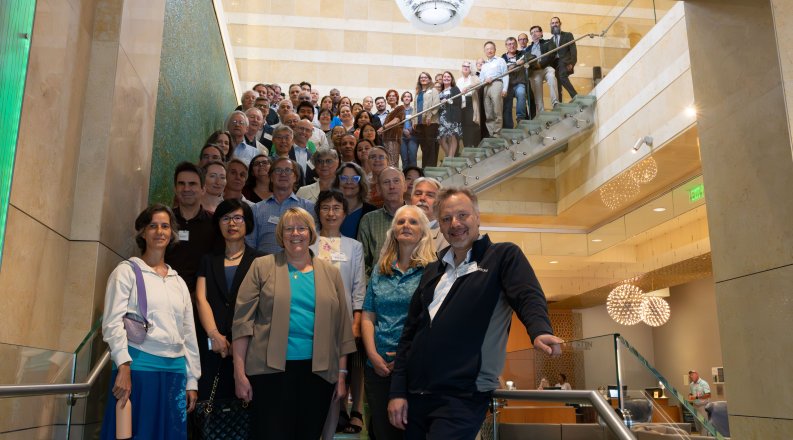FOR IMMEDIATE RELEASE: Oct. 4, 2023
Contact: Tiffany Whitfield, Old Dominion University, Strategic Communications and Marketing: (757) 683-5826, tlwhifi@odu.edu; and Gail Dodge, NSAC Chair, Old Dominion University: gdodge@odu.edu
The Nuclear Science Advisory Committee (NSAC: https://science.osti.gov/np/nsac/Reports) today announced the approval and release of A New Era of Discovery: The 2023 Long Range Plan for Nuclear Science (https://science.osti.gov/np/nsac/Reports). This new document provides a roadmap for advancing the nation's nuclear science research programs over the next decade. It is the 8th long range plan published by NSAC since 1979. The plan highlights the scientific opportunities of nuclear physics today to maintain world leadership in the context of four different budget scenarios and details progress since the last long-range plan. The document also features the impact of nuclear science on other fields and applications of the research that benefit society.
The major programs, accelerators, instruments and experiments that enable nuclear physics research in the U.S. are primarily funded by the Department of Energy Office of Science (DOE-SC) and the National Science Foundation (NSF). To ensure that these federal investments reflect the national interest, the two agencies regularly solicit input from practicing nuclear physicists through NSAC. NSAC is chartered under the Federal Advisory Committee Act and composed of 20 members who represent a range of subject matter expertise in nuclear physics.
“Every five to eight years, the federal agencies charge the Nuclear Science Advisory Committee to develop a plan to ensure the nation’s leadership in nuclear science based on community input. Today, NSAC approved the 2023 Long Range Plan for Nuclear Science after over a year’s work and difficult choices,” said NSAC Chairperson Gail Dodge, a nuclear physicist and Dean of the College of Sciences at Old Dominion University. “The 2023 Long-Range Plan lays out a compelling vision for nuclear science in the United States under multiple budget scenarios and is informed by international context.”
“Implementation of the plan’s recommendations will maintain the nation’s leadership and workforce in nuclear science,” she added. “What comes out of these discussions is a plan that will serve as input to DOE and NSF as they consider their research funding plans and priorities.”
Nuclear physicists lead the nation’s journey of discovery into the quarks and gluons that make up the protons and neutrons and atomic nuclei that build our visible universe. They investigate the nucleus of the atom at the heart of all matter, as well as the birth, life and death of stars, and the mysterious and fleeting neutrino. Vital, cutting-edge research and applications essential to national security, medicine and the environment are the product of nuclear physicists working to expand our knowledge of the past, present and future of our fascinating universe.
On July 11, 2022, DOE and NSF charged NSAC (https://science.osti.gov/-/media/np/nsac/pdf/202207/NSAC_LRP-2022-Charge_Letter_AAB37-Signed.pdf) with conducting a study of the opportunities and priorities for U.S. nuclear physics research and with crafting a new long range plan.
In the fall of 2022, town hall events were held to foster input for the new plan and to facilitate discussion among nuclear physicists. The town halls solicited and received numerous white papers (https://nuclearsciencefuture.org/?page_id=18) for consideration, covering the subfields (1) quantum chromodynamics, (2) nuclear structure, reactions and astrophysics and (3) fundamental symmetries, neutrons and neutrinos. Other groups also provided input related to crosscutting research and applications, such as quantum information science and technology for nuclear physics.
Dozens of nuclear physicists from across the nation developed the plan document with community-wide input. The development process included open forums, ongoing dialogue and grassroots input which were embraced by the many working physicists in nuclear science. “I am grateful to the many physicists who engaged with the process to provide input,” said Dodge. “The committee that developed the plan worked incredibly hard in a collegial and respectful manner, culminating in today’s approval.”
In addition to providing a framework for the coordinated advancement of the nation's nuclear science research programs, the plan features detailed information about the field’s national and international research programs and partnerships, describes the initiatives to advance science through cross-discipline collaboration and details how efforts to promote and sustain a diverse, equitable and inclusive nuclear science workforce are fully integrated into every aspect of the vision for the future of U.S. nuclear science.
For more information, NSAC established this website to provide timely updates on the 2023 planning process: NuclearScienceFuture.org.
The last Long Range Plan was released in 2015, called “Reaching for the Horizon” (https://www.osti.gov/biblio/1296778), this plan provided an overview of the field of nuclear physics and cited four main research priorities for the coming decade. The three previous long range plans were produced in 2007, 2002 and 1996.
####



